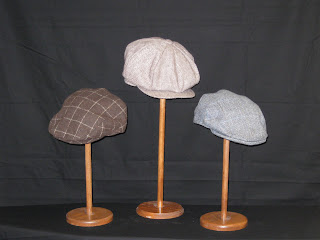The Housedress

Note;
I wrote the article below for our news letter eleven years ago.
Things have not changed much. The article illustrates extremely well how "nuts" you can become while trying to costume a living history museum.
May 15th, 2000
The Confession of an Obsessed Costume Coordinator
I have become obsessed with house dresses. A co-worker said I have OCHDD– obsessive compulsive house dress disorder. She may be right.
It all began innocently enough with a need for durable, versatile, easy care, yet attractive, dresses. House dresses are a part of women’s costume that never really caught my interest before. After all, they were just house dresses. But, the more I looked into house dresses, the more fascinated I became. The combinations of colors, prints and designs were intriguing. They came with square pockets, U and V-shaped pockets, long collars, scalloped collars, peter pan collars and no collars at all. They were trimmed with bias tape and rick-rack. I love rick-rack. The combinations seemed limitless. I was hooked. I made one, then another, then another.
I became preoccupied and restless. I spent sleepless nights tossing and turning designing house dresses in my mind. Floral house dresses, checked house dresses, house dresses trimmed with self-made bias tape in geometric designs. I needed help.
But the only help I got was in the form of encouragement from the Thursday sewing team of Jo, Joan, Rheta, Doreen and Les Lee to make more house dresses. Not only did they encourage me, but they also set to work seaming each dress to perfection without so much as a flinch. Where were the looks of complete puzzlement when I presented them with a new design? The heated discussions over my choice of fabric prints and colors? The grumbling had stopped. The raised eyebrows had dropped into looks of intense concentration at the task at hand.
Then it came. The pocket incident. A full blown bust up over pockets on a periwinkle blue house dress. This was more like it. But, to my disappointment, even this confrontation was short lived and work was promptly resumed. The pockets were placed dutifully and rightfully where I had wanted them. It was unnerving!
The costume training this spring featured a fashion show. Along with Tom as black smith, Glen as printer and Dianne as Glen’s blushing bride, I included two house dresses beautifully modeled by Lois and Marilyn. This was ground breaking stuff–a fashion show featuring house dresses.
Then the museum opened for the season. I put out a few house dresses for the women to look at comforting myself with the thought that no one would like these odd little dresses. But no, everyone liked them. They wanted more and more house dresses. I sat down and figured out how many dress I would need to fill the demand. With over 90 female volunteers and staff interpreters in approximately 45 different sizes the numbers became staggering. I hurried out and purchased more fabric, a lot more fabric. I made more house dresses all the time telling myself just one more house dress and then I’ll stop. Not so. The more I made, the more I wanted to make.
Then it struck me. The cure for this disorder was simple. The money in the costume budget would soon run out. This was the answer no more money, no more fabric, no more house dresses. But at the thought of going through house dress withdrawal, my heart began to pound and I broke out in a cold sweat. When the time comes and I am out of money and out of fabric, I hope I can be strong enough to overcome my obsession. But, then again, all I need is 3.5 meters of 100% pretty printed cotton to make just one more house dress. I have heard of people selling their souls for less.

 Any one who strikes out on the path of making a hat could risk going quite mad. The variety of styles, materials, trim and size is enough to put fear into the strongest costumer. There are many times in fashion history when not only the garment shapes are hard to see because of the trim but the hats are adorned with so many feathers, flowers, ribbon, lace, netting and hat pins it is hard to see the shape of the hat itself.
Any one who strikes out on the path of making a hat could risk going quite mad. The variety of styles, materials, trim and size is enough to put fear into the strongest costumer. There are many times in fashion history when not only the garment shapes are hard to see because of the trim but the hats are adorned with so many feathers, flowers, ribbon, lace, netting and hat pins it is hard to see the shape of the hat itself. 































